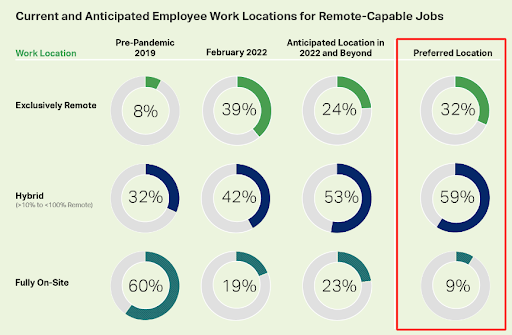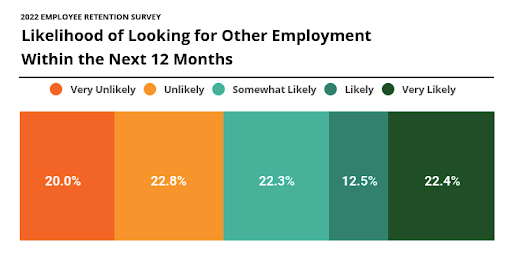5 Reasons Why Businesses Should Consider Investing in Hybrid Workforce Analytics
12 Jun

Table of Contents
ToggleAs companies discover the benefits of flexible work arrangements, we see them adopt hybrid workspaces. Rather than working fully remotely or fully on-site, teams can choose a flexible arrangement that gives them the benefits of both worlds.
They can be on-site for team collaboration exercises. However, they can work remotely when they need to do heads-down work.
Without direct access to your employees at all times, it can be difficult to determine if your hybrid work arrangement is working. That’s where hybrid workforce analytics comes into play.
Today, we’re exploring the reasons to invest in hybrid workforce analytics. See the value in regularly tracking employee engagement and performance.
What Are Hybrid Workforce Analytics?
A recent Gallup study found that 59% of the workforce prefers a hybrid arrangement.

To maximize employee productivity, you may already have or are thinking of implementing hybrid working policies for your organization.
Don’t do it blindly. One of the reasons to invest in hybrid workforce analytics is to know if your flexible arrangement is working or not. The key metrics include:
- Employee productivity
- Employee performance
- Employee engagement
- Office space utilization
- Workforce resource needs
- Attendance
- Management needs
Gathering and analyzing this data empowers you to address the challenges of your hybrid work arrangement proactively.
To further enhance data accuracy and avoid potential IP bans, using reliable residential proxy servers enables seamless collection of insights into employee work habits, boosting the effectiveness of your decision-making.
5 Reasons to Invest in Hybrid Workforce Analytics
Below are the reasons hybrid workforce analytics is important if you’re implementing hybrid work policies in your organization.
1. It Helps You Determine if a Hybrid Arrangement Is Working for You.
There are many benefits to implementing a hybrid work arrangement. For instance, you get to enjoy:
- Reduced operational costs
- Increased flexibility
- Enhanced employee engagement and productivity
- Increased employee satisfaction
- Access to a wider talent pool
However, it’s important to note that hybrid working isn’t for every company. Some companies need employees to work on-site, while others thrive when everyone is completely remote.
For instance, a startup digital marketing agency offering influencer marketing services may do well with a remote work setup. Their operations can be done online—advertising their services, recruiting influencers, and collaborating with influencers to run brand campaigns.
However, if this type of company implements a hybrid working arrangement, workplace analytics can help determine if the arrangement is working for them.
In this case, a reason to invest in hybrid workforce analytics could be office space utilization. It provides insight into how much office space is being utilized. If data shows that not enough employees work onsite, the company may opt to revert to a purely remote working arrangement.
2. It Provides Insight into Technology and Tools Usage.
In today’s digital age, even employees who work purely on-site need certain tools and software to get the job done. For example, even if a digital marketing agency is completely on-site, it’ll need social media analytics tools like the ones in this guide by Attrock to measure the effectiveness of its campaigns.
However, in addition to technical tools for normal day-to-day work, the following tools are important for hybrid teams:
- Collaboration tools
- Productivity apps
- Project management tools
- Team communication tools
- Cloud storage solutions
To ensure seamless collaboration among remote teams, visual collaboration tools may be necessary. This is where workplace analytics come in. For example, an employee satisfaction survey can help you decide what tools to use, what’s working, and what needs to be optimized to support a hybrid work environment.
3. It Helps You Measure Employee Productivity.
Managers can use hybrid workforce analytics to measure employee productivity. The planned-to-done metric is particularly helpful as it helps managers measure how much of the assigned work an employee has completed.
This metric provides valuable insights that can be used to boost company performance. For instance, if one employee has a planned-to-done ratio of 40% when everyone else scores more than 90%, this could be an indication that the employee is underperforming.
The planned-to-done metric can also be used to measure the performance of an entire department. A low score could indicate that a department has too much work and not enough staff.
The management can then hire more people to reduce the workload and improve productivity.
4. It Helps with Employee Retention.
Employee retention is among the top reasons to invest in hybrid workplace analytics. A recent employee satisfaction survey found that 57.2% of employees are likely to look for new opportunities in the next 12 months.

As an employer, you don’t want to lose your best employees. When employees are happy, it’s easy to retain them.
In a hybrid work setup, employers can benefit from knowing how their employees work best. This includes collecting data on their preferred work locations, times, and environments.
Employers can accommodate these preferences to enhance job satisfaction and loyalty. Collaboration patterns can also be collated to help identify potential challenges and opportunities to enhance teamwork, which is particularly crucial for remote work.
5. It Helps You Manage Resources More Effectively.
One of the challenges of a hybrid arrangement is ensuring employees have the resources to perform optimally. To reduce operational costs, most hybrid teams use a desk booking system where employees reserve space when they need to work from the office.
Workplace leaders can use this data to know how many desks are needed in the office at any given project time tracking. This data will also help you make a well-informed decision if you find out that your office space is being underutilized.
Additionally, hybrid workplace analytics help you allocate office supplies more effectively. For example, if on-site employees receive certain office supplies like notebooks and peripherals like cables, you’ll know how many of these you need at any given time.
You can also use historical data on desk booking to budget for office supplies in advance.
Final Thoughts
Hybrid workplaces have numerous benefits for organizations. The flexibility of this work arrangement enhances productivity and employee engagement.
However, to find out whether hybrid work is working for your organization, you need workplace analytics. It also helps you determine areas for improvement so you can fully take advantage of this unique work setup.
We have shared the many reasons to invest in hybrid workforce analytics, including technology and tools usage, employee retention, measuring productivity, and efficient resource utilization.
To effectively implement workplace analytics, choosing the right tools for data collection is paramount. You also need to determine what you’d like to know about your hybrid workforce so you can come up with the right solution to gather the data you need.

Author Bio – Reena Aggarwal
Reena is the Director of Operations and Sales at Attrock, a result-driven digital marketing company. With 10+ years of sales and operations experience in the field of e-commerce and digital marketing, she is quite an industry expert. She is a people person and considers the human resources as the most valuable asset of a company. In her free time, you would find her spending quality time with her brilliant, almost teenage daughter and watching her grow in this digital, fast-paced era.
Related Post
Recent Posts
- MEP Document Management: How to Streamline Reviews & Avoid Rework October 3, 2025
- What Is Online Proofing Software? And Why Content Review Breaks Without It July 11, 2025
- How Laerdal Medical Cut eLearning Review Time by 50% with zipBoard’s Visual Review Tool July 9, 2025
- Why Your Team Needs a Content Feedback System (Not Just Comments in Docs) May 28, 2025
- Content Approvals Are Slowing You Down — Here’s the Fix May 26, 2025
©️ Copyright 2023 zipBoard Tech. All rights reserved.

